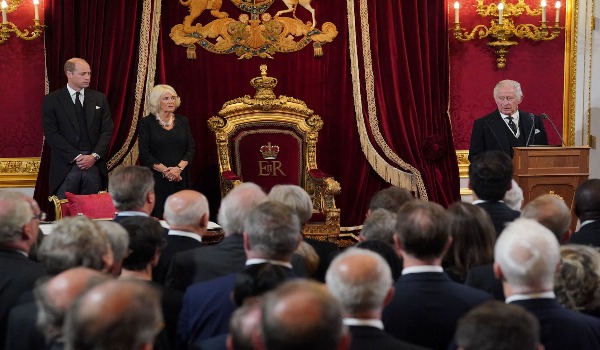Accession Council formally proclaims Charles III king, new British monarch
The senior officials known as Accession Council has formally appointed Charles III as the new British sovereign in a session on Saturday morning in the state apartments of St James’s Palace, marking one of the final steps in his taking over the crown after the passing of Elizabeth II on Thursday.
The proclamation, which was read by the clerk of the Council, was then signed by key signatories such as the Prince of Wales and the Queen Consort.
“Charles III, by the grace of God of the United Kingdom of Great Britain and Northern Ireland and of his other realms and territory, King, head of the Commonwealth, defender of the faith, to whom we do acknowledge all faith and obedience with humble affection, beseeching God by whom kings and queens do reign to bless His Majesty with long and happy years to reign over us,” the proclamation read.
The Accession Council was followed by the Privy Council held by the King, with Charles III making a series of oaths and declarations.
The historic session proclaiming Charles III as the new sovereign was followed by the reading of the Principal Proclamation from the palace’s balcony, followed by fanfare and gun salutes.
The new King, who will not be present for the Accession Council session, will hold his first Privy Council after the ceremony.
In his first address as monarch from Buckingham Palace, King Charles III said the Royal Family owed a “heartfelt debt” to his mother, and vowed to carry on her “lifelong service”.
Charles said his son William would succeed him as Prince of Wales, with William’s wife Catherine becoming Princess of Wales.
The ceremony, which was televised for the first time, gathered 250 officials, including all six living former prime ministers and senior church figures.
Charles’ son William, who was given the title of Prince of Wales by his father on Friday, will be present.
Already, a remembrance service for Queen Elizabeth II, who died at Balmoral on Thursday aged 96, has been held at St Paul’s Cathedral in London.
As tributes continue to flood in from around the world for the Queen, a period of national mourning has been declared until the end of the day of the state funeral.
At midday on Friday, bells tolled at Windsor Castle, Westminster Abbey, and St Paul’s Cathedral.
Gun salutes also took place across the UK as well as in Gibraltar and Jersey, with one round fired for each year of the Queen’s life.
Subsequent days:
— The Queen’s body is moved from Balmoral Castle in the Scottish Highlands to Edinburgh, where the coffin is likely to rest at Holyrood Palace before being moved to St. Giles’ Cathedral so members of the public can pay their respects.
— The coffin will be transported by train or plane to London.
— The Queen will then lie in state for several days in Parliament’s Westminster Hall, where the public will again be able to pay their respects.
— A state funeral at Westminster Abbey will be attended by leaders and dignitaries from around the world.
— The period of national mourning will end after the day of the Queen’s funeral.




